The top trail bikes as rated by our expert reviewers, plus our buyer’s guide for everything you need to know
The best trail bikes hit the sweet spot between rowdy enduro bikes and svelte cross-country bikes, delivering performance that’s equal parts fun and super-capable.
This has made trail bikes an incredibly popular category among the best mountain bikes in recent years. They give you a bit of everything, and open up the widest range of trails and riding when compared to other types of mountain bike.
The flipside is that choosing the best trail bike for you can be quite a bewildering prospect – there are simply so many options on the market.
Fortunately, you’ve come to the right place because our expert mountain bike testers have spent years riding and reviewing dozens of trail bikes. This list of the best trail bikes in 2024 will help you find the perfect machine for you.
We’ve also put together a buyer’s guide to trail bikes at the end of this list that explains everything you need to know about this type of mountain bike, from what sort of terrain they are good for to the size of disc brake rotors – we’ve covered it all!
Best trail mountain bikes in 2024
Atherton AM.130.1
- £7,800 / $7,735 / €7,345 as tested
- Pros: Impressive suspension; agile and composed ride feel; head-turner
- Cons: Pricey; not the latest spec for the price
Atherton’s AM.130.1 is made using an additive construction technique that sees carbon tubes connected with 3D-printed titanium lugs, enabling the brand to offer the bike in 22 frame sizes.
A DW6 linkage gives the bike a good balance of sensitivity and support, with its small-bump compliance making trail imperfections disappear without losing response to direct inputs.
The bike comes with SRAM’s X01 mechanical groupset, which is far away from the electronic groupsets usually found at this price point.
Boardman MTR 8.9

- £1,750 as tested
- Pros: Fantastic all-rounder
- Cons: Limits become clear on extreme terrain
The Boardman MTR 8.9 has the same geometry and suspension as the pricier MTR 9.0.
It has a well-chosen spec that balances cost, performance and strength, with a RockShox front fork, a SRAM NX Eagle drivetrain and Maxxis tyres.
The triple-butted alloy frame looks purposeful and has externally routed cables, making for easy maintenance. There is a bottle mount too, but we found there to be minimal clearance.
The geometry is modern but not extreme with a generous reach, leading to a comfortable ride.
You do have to shift your weight forward to keep front-wheel traction over tricky ascents, and downhill the bike is fairly noisy. So really this is a bike for speedy trail centre rides, rather than super-challenging terrain.
The bike is also ripe for upgrades and, with a few parts swapped out, we think it would be great as a lightweight, mile-munching machine.
- Read our full Boardman MTR 8.9 review
- Buy now from Halfords
Cannondale Habit 4
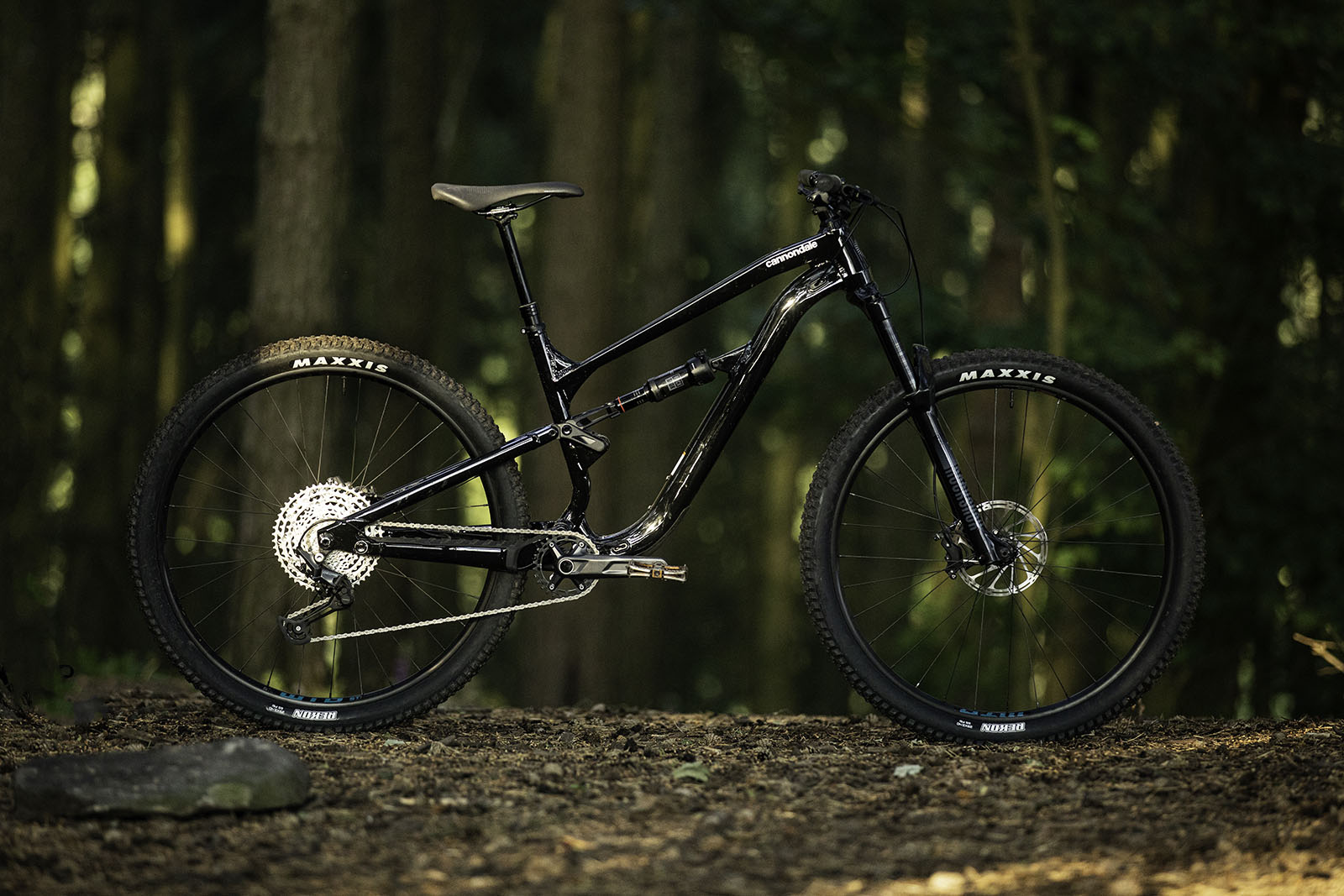
- £2,300 / $2,300 / €2,699 / AU$4,399 as tested
- Pros: Well-balanced; confidence-inspiring ride; fun and flicky
- Cons: Shimano Deore drivetrain can be a little clunky
The Habit 4 impressed us with its playful and balanced ride feel.
Its aluminium frame features size-specific geometry. Cannondale increases the chainstay length with the frame size making the Habit. The bike feels surefooted and quick to turn.
We found the RockShox Recon fork to bind on hard compressions, though this didn’t take too much away from the performance of the bike.
A steep seat tube angle of 77.5 degrees makes winching up climbs comfortable, though the bike lacks some of the punchiness of other bikes on this list.
Canyon Neuron 5

- £1,849 / $2,099 / €1,899 / AU$2,949 as tested
- Pros: Fast rolling on mellow trails; composed ride feel; grippy in most conditions
- Cons: Suspension feels overworked on steeper trails
Canyon’s Neuron covers ground fast, with supple suspension that provides good comfort while descending, although, it can feel a tad active on steeper, technical descents.
The bike has a nimble ride feel that helps it eat up trail centre singletrack with ease, with the Schwalbe tyre combo offering fast rolling speeds.
We found the RockShox Recon fork to be a little out of tune with the rear of the bike, and not providing the desired amount of support on steeper terrain.
Merida One-Forty 700
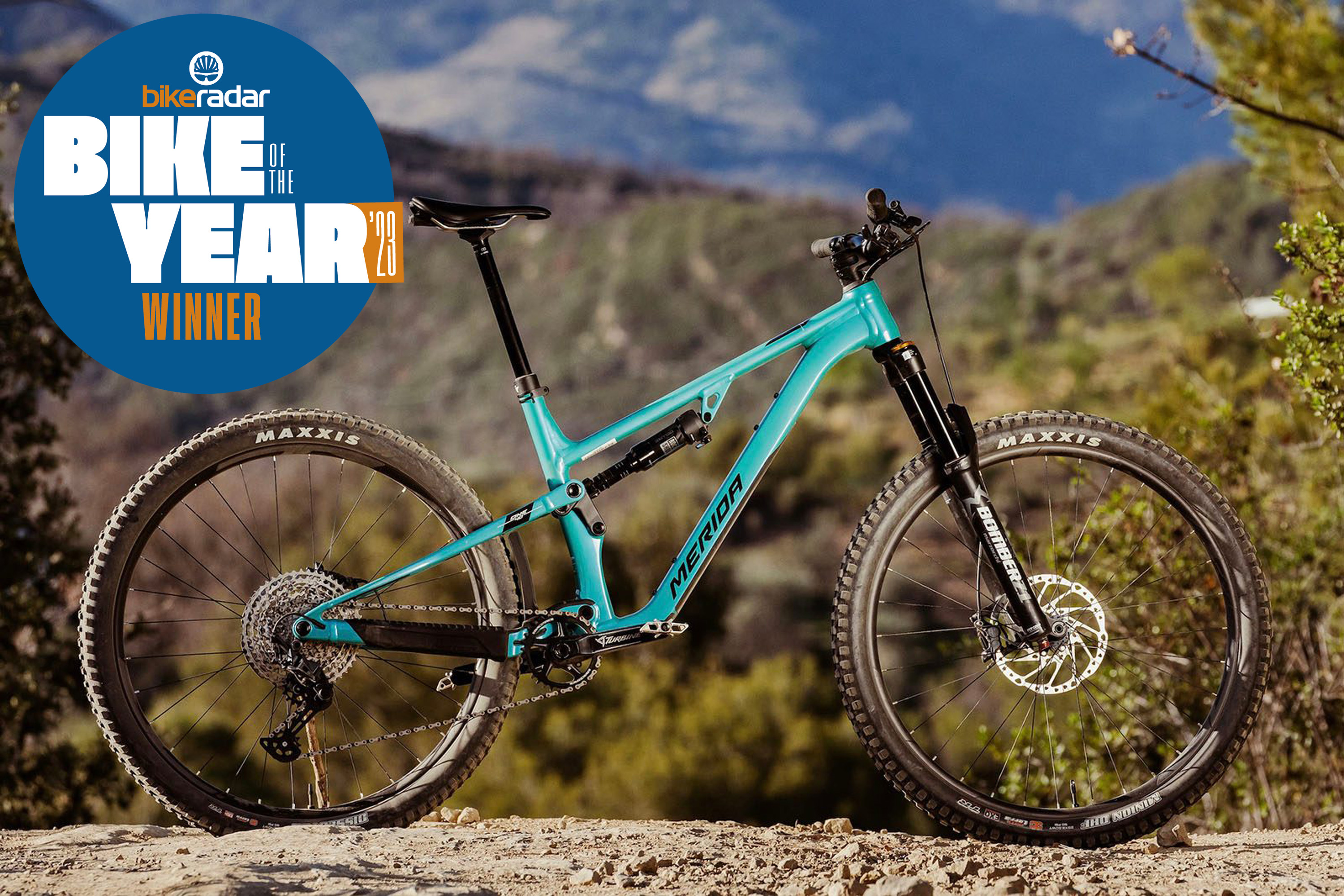
- £3,100 / €3,869 as tested
- Pros: Boundary-pushing geometry options; one of the best climbers out there
- Cons: Stem could be shorter; not the smoothest ride
The Merida One-Forty 700 impressed us in testing, winning our Trail Bike of the Year 2023 award.
The carbon fibre frame, which is shared with the longer-travel One-Sixty, uses flex stays in the rear linkage and provides 140mm of rear travel.
Merida has packed serious value for money into the bike, with a RockShox Deluxe Select rear shock and a 150mm Marzocchi Z1 fork.
On climbs, the bike has zero wallow and a perky attitude, making the uphills easier than on its contemporaries.
Downhill, the geometry is spot on with composed and accurate handling adding to the ride.
Norco Fluid FS C2

- £4,999 / $4,999 / €5,299 as tested
- Pros: Confidence-inspiring geometry; makes good use of suspension travel
- Cons: Brakes could be more powerful; tyres won’t suit everyone
Norco’s Fluid FS C2 has a playful agility on the trail that remains composed at high speeds.
With a 140mm RockShox Pike Select fork up front and a Super Deluxe Select controlling 130mm of rear-wheel travel, the Norco feels planted through rough terrain, balancing a poppy yet bump-gobbling ability.
We found the Fluid capable of all aspects of trail riding, but it was on the hills where it really impressed, with the bike eager to attack short, sharp climbs with grace.
Because it’s able to carry a lot of speed down the trail, the SRAM G2 RS brakes feel a little under-gunned in some situations, with the bike deserving of more powerful brakes.
Vitus Escarpe 29 CRS

- £3,200 / $3,599 / €3,899 as tested
- Pros: Super-smooth and confident descending; stunning value for money
- Cons: Limited climbing performance
Vitus is becoming synonymous with value for money, with the Chain Reaction direct brand giving the Escarpe 29 CRS a similar treatment.
The full carbon fibre frame has 140mm of rear travel controlled by a RockShox Deluxe Select and the front end is supported by a 150mm RockShox Lyrik Select.
The Escarpe is more descent-focused compared to other trail bikes, with its climbing performance limited by pedal bob and increased sag on steeper pitches.
Downhill, the bike smooths terrain and offers a confidence-inspiring ride over a broad range of trails.
YT Jeffsy Core 1

- £2,499 / $2,799 / €2,499 as tested
- Pros: Confidence-inspiring geometry; good spec for the money; fork performs well
- Cons: It’s not the the lightest
YT’s entry level to the Jeffsy range offers the value for money often associated with the German direct-to-customer brand.
The bike offers impressive capability, tackling enduro trails with ease while remaining playful on mellower trails.
A centred riding position gives you plenty of confidence to push the bike to the limit on the descents. A steep 77.9-degree seat angle puts your weight over the BB, helping on technical climbs.
It’s not the lightest trail bike we’ve tested, but we feel this is less important with it sitting towards the more aggressive side of the segment.
Boardman MTR 9.0
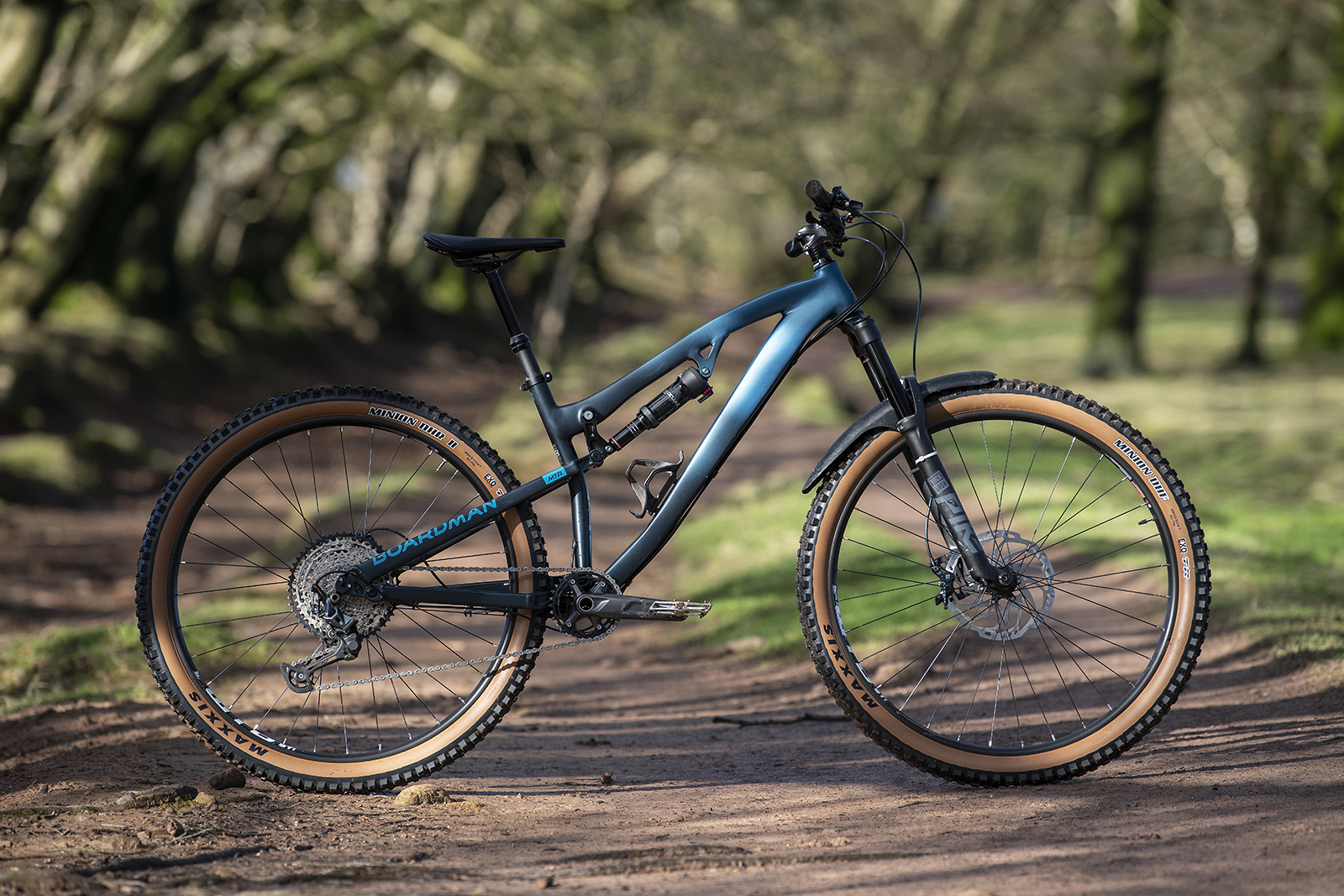
- £2,000 as tested
- Pros: Rides with confidence and has excellent brakes; RockShox fork and rear shock
- Cons: Contact points detract from overall package
The MTR 9.0 is Boardman’s flagship mountain bike, with an upgraded alloy frame, 150mm RockShox fork, a Deluxe Select rear shock and a groupset that is, by and large, comprised of Shimano SLX-level parts.
The bike is happiest heading downhill, where it feels planted, and the Shimano SLX four-piston brakes provide a whole load of stopping power.
The MTR climbs reasonably well. The relatively steep seat-tube angle helps you get your weight over the bottom bracket, and the wide-ranging 10-51 tooth cassettes help winch you up the toughest climbs.
The bike has a dropper post, which is great for such a gravity-focused bike, but the dropper lever is a bit small and not the easiest to use.
The bike rides with more confidence than you might expect and, apart from the dropper lever, there really isn’t much to fault.
- Read our full Boardman MTR 9.0 review
- Buy now from Tredz
Boardman MTR 8.8
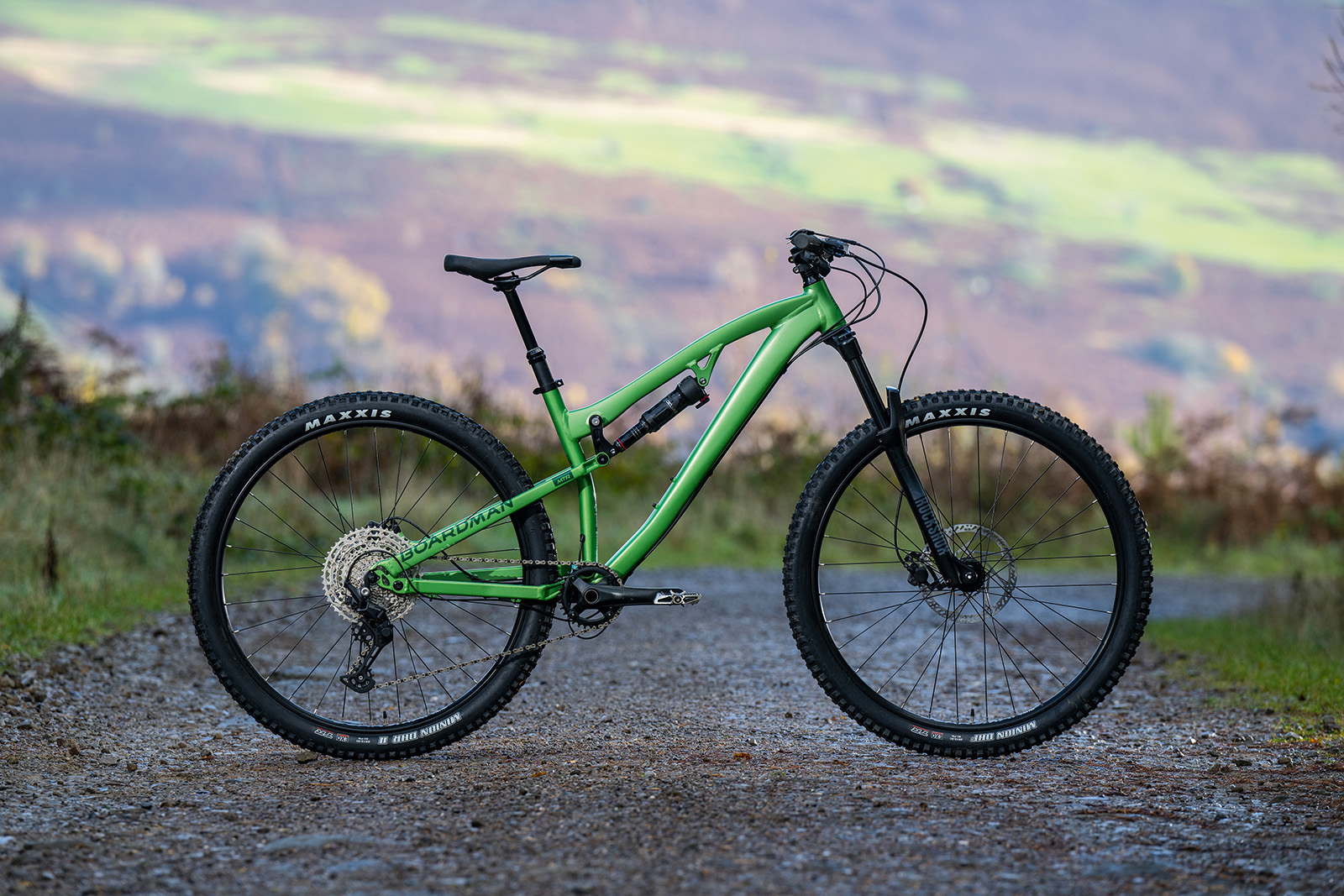
- £1,350 as tested
- Pros: Impressive spec for the price; good suspension feel
- Cons: underpowered brakes; dropper post length
Boardman’s MTR 8.8 is built to be the ideal all-round UK trail bike. It’s very capable when pointed down a trail, thanks in part to the 145mm of rear suspension controlled by a RockShox Deluxe Select , and 150mm RockShox Recon Silver RL fork.
Considering its suspension travel, it climbs very well, but it’s the descents where the Boardman shines.
In its price range, there aren’t many bikes that can provide the same levels of performance. However, a couple of spec changes, such as a longer dropper post and more powerful brakes, would make the riding experience even better.
Canyon Spectral 125 CF 7

- £3,349 / $4,199 / €3,499 / AU$5,349 as tested
- Pros: Aggressive geometry and stiff, low-slung frame; great handling on really steep terrain
- Cons: Sluggish at slow speed on mellow terrain; thin tyres
A shorter-travel trail bike, the Spectral 125 mixes that with a 140mm-travel fork and a long reach geometry that’s built for more aggressive riding. It’s a different, all-carbon frame from the longer-travel Spectral bikes and saves 100g in weight.
The stiff, aggressive, low-slung frame is great for bikepark laps and climbs, but you need to increase the sag from the recommended values for the bike to handle rock gardens comfortably.
The bike navigates super-steep terrain admirably though, with the long frame helping to maintain stability. It pays to tinker with the Spectral 125’s suspension settings and to ride hard to get the best out of the bike.
Want a spec upgrade? We’ve also tested the Canyon Spectral 125 CF8.
Carrera Titan X
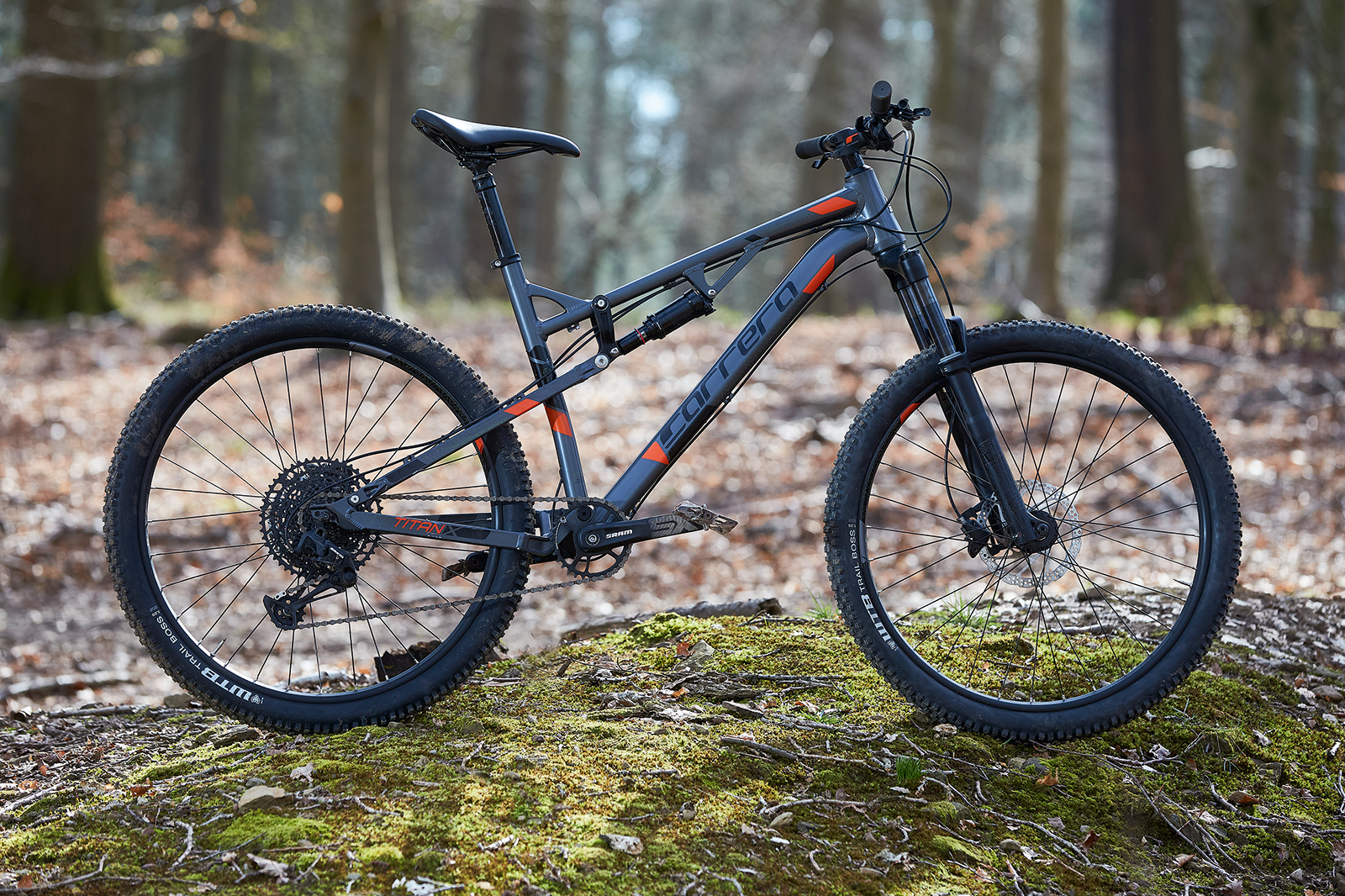
- £850 as tested
- Pros: Excellent spec for the price; a real advantage over hardtails at this price
- Cons: limited size range
Full-suspension bikes for under £1,000 are a rarity, and ones that are as well-specced as the Carrera Titan X are rarer still.
The kit on this bike is really impressive. It has SRAM SX 12-speed gearing with a 1x setup, a Trans-X dropper post and Shimano hydraulic brakes. In short, what you’d expect from a pricier bike.
When it comes to ride performance, the Titan X’s suspension works surprisingly well, making this bike a good shout over a hardtail – which is normally the go-to option at this price point.
When climbing, the Titan X’s frame is a little cramped due to its relatively old-school geometry, but it winches up hills better than you might expect.
The only real drawback to the Titan X is the limited sizing, and taller riders should stay clear. This is a real try-before-you-buy bike, but if it fits and you’re on a budget, it’s a compelling option.
- Read our full Carrera Titan X review
- Buy now from Halfords
Cotic Jeht Silver Mullet

- £3,989 as tested
- Pros: Composed and confident; smooth feeling suspension
- Cons: Stiff suspension under braking; feels large
The Cotic Jeft is made from Reynolds 853 steel with a steel-alloy rear triangle that has 140mm of suspension travel.
Its long, low and slack geometry is on point and allows you to let the bike run through the techiest of sections while still feeling in control.
The Jeht is a fairly tall bike, and when braking the rear suspension isn’t as good as some of the competition, especially those bikes using a four-bar design.
The spec can be matched to your pockets, with our test bike featuring an upgraded RockShox Revelation fork with a Charger 2.1 damper.
Focus JAM 8.9

- £4,799 / €4,699 / AU$6,999 as tested
- Pros: Impressive suspension maintains ground contact well; clever internal frame storage
- Cons: Hefty weight; complicated stem design
With 150mm of travel, the JAM 8 series bikes get a carbon front triangle with neat internal storage and share geometry with the alloy JAM 6 series. There’s also tidy internal routing through the stem for the cables.
The new suspension design, with its flip chip, leads to a better-supported mid-stroke than Focus’s older system, leading to a more playful ride and less chance of bottoming out. It also helps keep contact with the ground well at the rear on descents.
The mix of agile handling and stable suspension leads to an exciting ride, and it’s easy to pick and change your line, although the Fox 36 Performance fork feels more limiting than the rear travel.
GT Sensor Carbon Pro LE
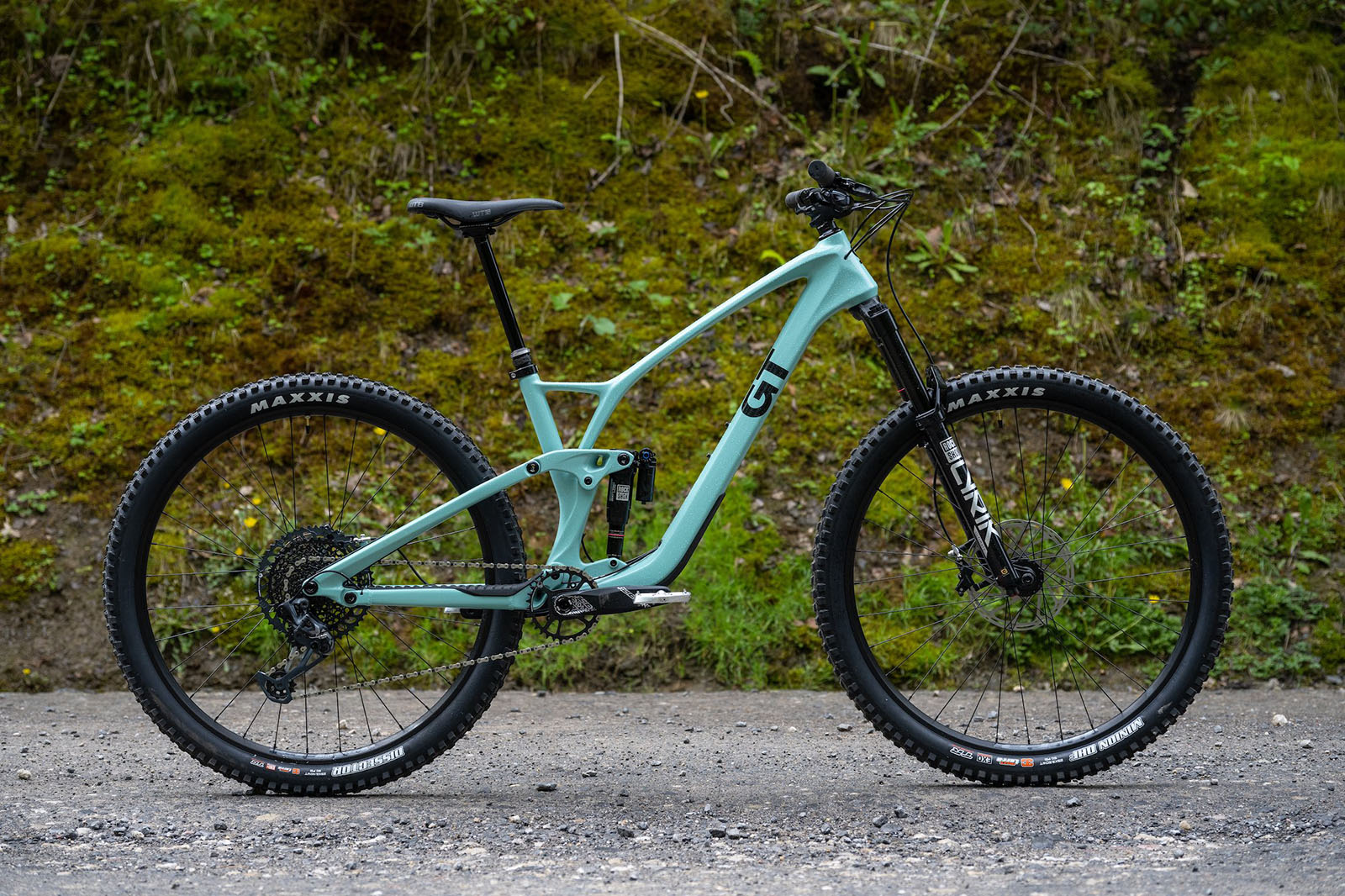
- £5,000 / $5,750 as tested
- Pros: Great for rowdy trail riding; RockShox suspension works very well; ideal for those looking for simplicity
- Cons: Freehub engagement is clunky; SRAM G2 RSC brakes struggle with power down steep trails
GT’s Sensor Carbon Pro LE feels very capable on rougher trails considering its suspension travel, with the 150mm fork and 140mm rear-suspension travel combination providing a composed ride on gnarly trails.
The Sensor certainly prioritises downhill prowess, with the bike remaining poppy and responsive whatever the gradient.
The RockShox Lyrik Ultimate fork and Super Deluxe Ultimate shock provide composed damping, but SRAM’s G2 RSC brakes are a little lacklustre when shedding speed.
Kona Honzo ESD

- £2,899 / $3,099 / €3,299 / AU$4,399 as tested
- Pros: Very smooth ride over the rough stuff; descends better than a hardtail should
- Cons: Not great value for money
It may be a hardtail, but the Kona Honzo is long and slack enough to handle the steepest descents, with a braced steel frame, 150mm-travel fork and plenty of room for aggressive rubber. Adjustable rear dropouts enable you to fine-tune your ride or go singlespeed.
There’s bags of stability on steep descents and the bike is great at carving wide corners, but shorten the rear end and direction changes come really easily. You’ve got a 203mm rotor at the front and 180mm out back to help control your speed.
The Honzo’s steep 77.5-degree seat tube helps with climbing and it’s got plenty of room for the long-travel TransX dropper post.
We were impressed by the climbing performance, aided by a 30t chainring and a wide-range 10-51t cassette, while the bike’s length means you can shift your weight around both up and downhill. It’s a hardcore hardtail that shows you don’t need suspension out back to have fun.
Marin Rift Zone XR 27.5

- £3,095 / $3,500 / €3,499 as tested
- Pros: Well-designed frame; excellent rear suspension
- Cons: Brakes lack bite; not the best climber
The Marin Rift Zone XR is built on the alloy Rift Zone frameset which provides top-notch rear suspension while prioritising front-end control.
The Fox Float X rear shock works well to support the rear end, giving the bike playfulness without sacrificing grip.
The bike’s poppy character makes for an engaging ride, though the bike requires rider attention on gnarlier sections of trail.
A ‘sit up and spin’ attitude to climbing is provided by the upright and relaxed position, with the bike featuring more pedal bob than its competitors.
Merida One-Forty 500

- £2,600 / €3,160 as tested
- Pros: Efficient pedalling; playful handling; good spec for the money
- Cons: Rear-end grip isn’t the best in the wet; brake bite point can wander
The One-Forty 500 uses the same frame as the One-Forty 700 that we awarded Trail Bike of the Year in 2023.
At this lower price point, the bike remains an impressive performer with eager climbing characteristics and supportive suspension on the descents.
The bike offers an impressive spec for the money, though we did find the Shimano Deore four-piston disc brakes a little unpredictable, with a wandering bite point affecting the accuracy of our braking.
Merida One-Twenty 700

- £3,100 as tested
- Pros: Progressive suspension; confident handling; efficient pedalling
- Cons: Front end is quite harsh; brakes are average
Despite its name, the One-Twenty 700 has 130mm of suspension travel front and rear, which does a stellar job of climbing thanks to Merida’s P-Flex flex-stay suspension linkage.
While the bike isn’t the most composed on the downhills, the long and low geometry still eggs you on to push the brakes and tyres to their limits.
The RockShox Pike Select fork and a RockShox Deluxe Select shock work well to iron out the bumps, but the SRAM DB8 brakes feel a little underpowered when hitting the trail at full speed.
Polygon Siskiu T7 29
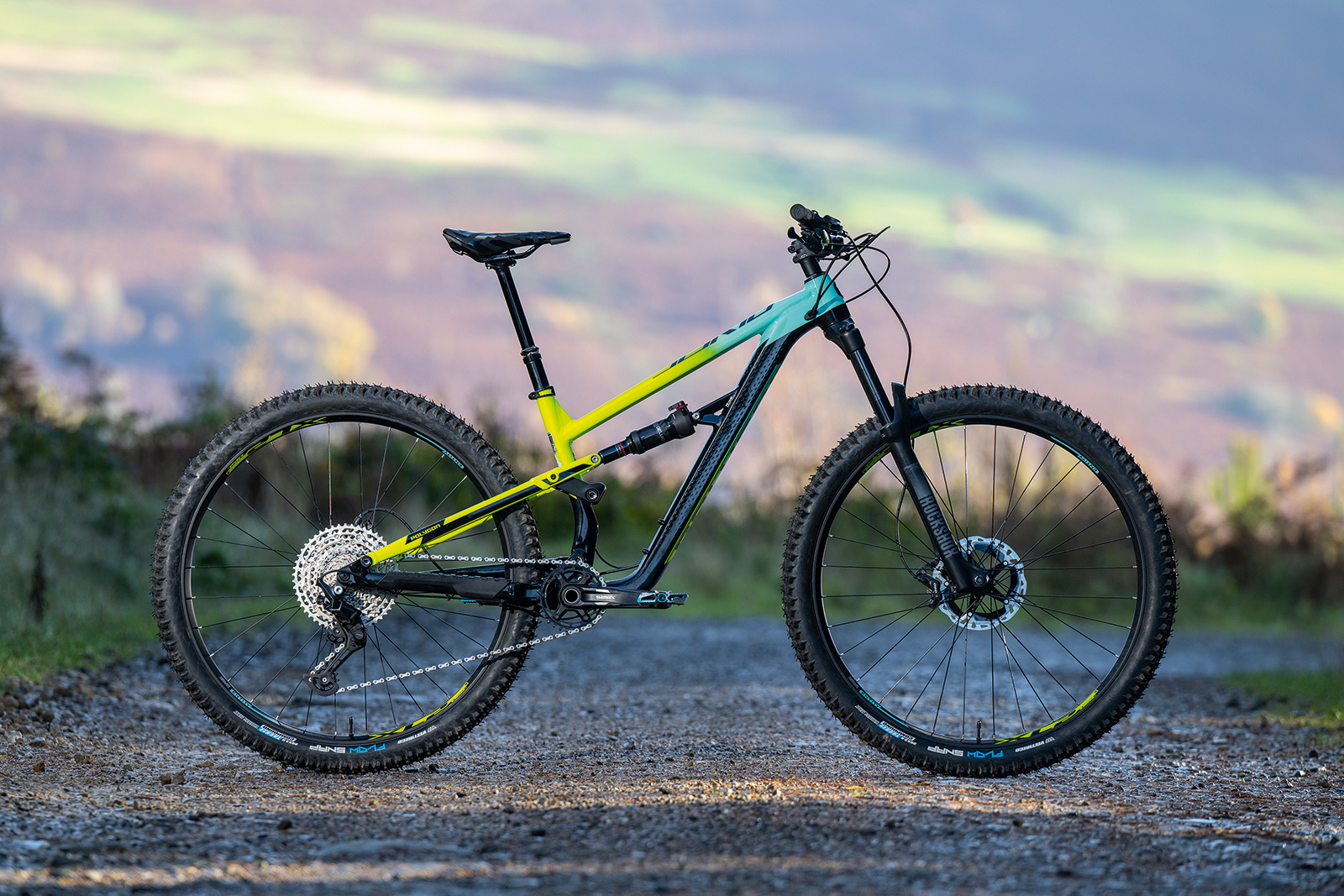
- £1,800 as tested
- Pros: Great trail geometry; impressive value for money
- Cons: Brakes are a weak point
The Polygon features modern trail geometry and decent components that make it very capable on the descents, with the 65.5-degree head angle giving confidence on even the steepest terrain.
A RockShox Deluxe Select controls 135mm of rear-suspension travel, while a 140mm RockShox Recon Silver RL fork supports the front. The bike comes with Shimano’s Deore 1×12 drivetrain with Tektro’s HD-M735 brakes.
Polygon’s Siskiu will take all you can throw it, but is maybe not as responsive as bikes twice its price. If you are a GoOutdoors member, however, you can get the bike at the reduced price of £1,600.
Santa Cruz 5010 CC X01 RSV

- £7,599 as tested
- Pros: Composed and fun; only 130mm of travel, but still capable
- Cons: Pricey build
The new Santa Cruz 5010 CC X01 RSV is the brand’s top-flight version of its 5010. The bike has an updated geometry that sees it getting lower and longer, and it now has Santa Cruz’s low-slung VPP (Virtual Pivot Point) design. It sticks to 650b wheels though and retains the fun factor of previous models.
The suspension comes in the form of RockShox’ top-spec kit on the front and rear, providing 140mm/130mm of travel. Paired with the new geometry, this creates a ride that is capable and fast on descents, remaining composed but spurring you on, and is incredibly energetic on climbs when pushing power through the pedals. The handling is also razor-sharp.
Fittingly for this carbon fibre bike, and its significant price tag, the finishing kit is top-tier too, with SRAM drivetrain and brakes and Santa Cruz’s own carbon Reserve rims built around DT Swiss hubs.
This all comes together to create a bike that is seriously fun to ride. It’s not quite as playful as previous versions, but it is more capable and faster. And if the price is too steep, Santa Cruz offers the 5010 in less expensive builds.
Specialized Stumpjumper Comp
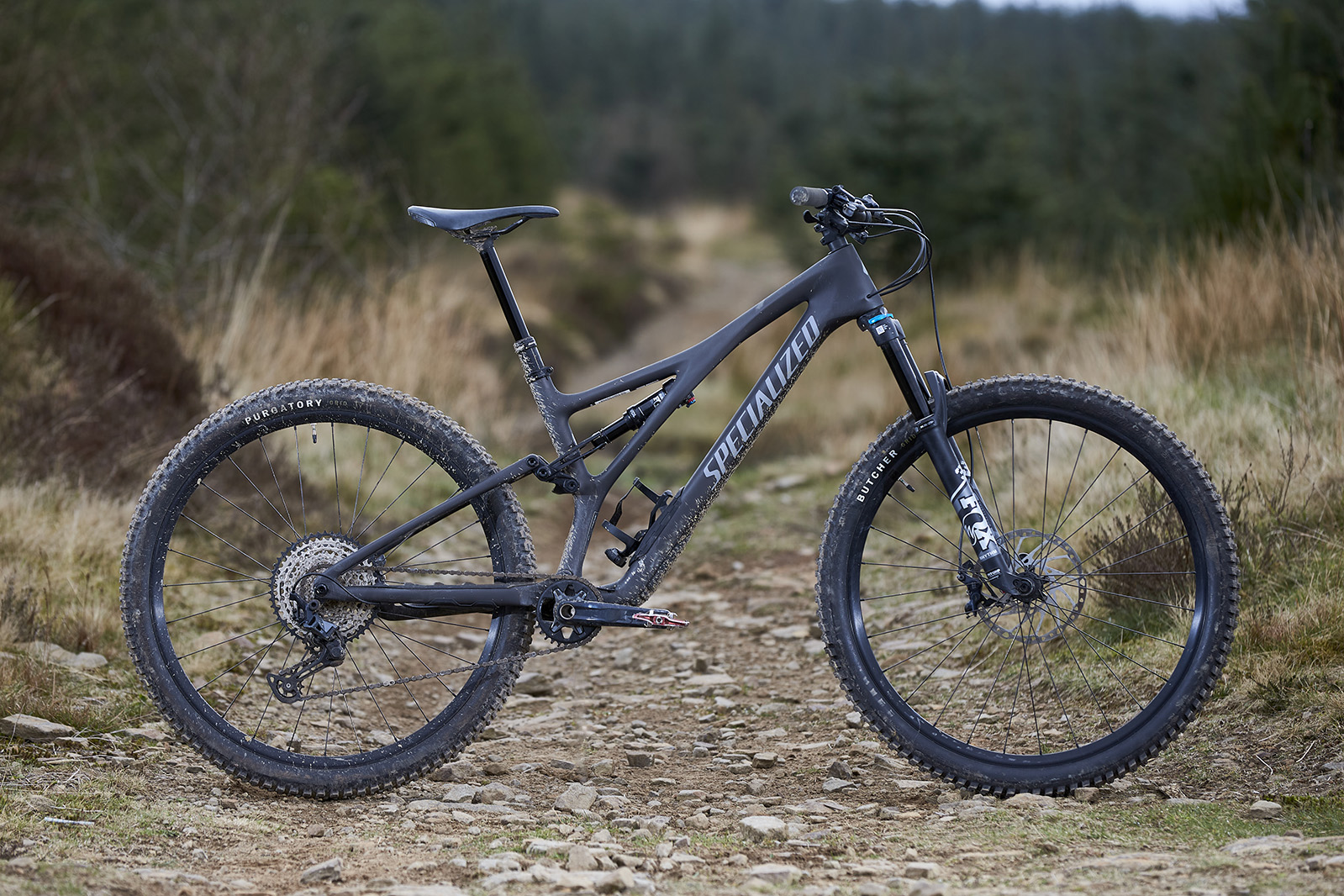
- £3,950 / $5,000 / €5,000 / AU$7,200 as tested
- Pros: Smooth suspension and great chassis; excellent rear-end grip
- Cons: Specialized’s tyres; pricey for the build
It may be the cheapest carbon Stumpjumper, but the Comp spec still delivers impressive performance from its 130mm-travel and flip-chip tunable geometry – the EVO version gets a little more travel and more aggressive geometry.
Rear suspension is smooth and leads to great grip for the Specialized Purgatory tyre. The Stumpy handles well on slow, technical descents, aided by the Fox 34 fork, but there’s some chassis squirm and an unsettled feel on more aggressively ridden terrain. We reckon it works best on day rides on singletrack or trail centre loops.
Spec-wise, the Comp has a Shimano SLX groupset, X-Fusion Manic dropper and Specialized wheels and tyres. SWAT Door storage lets you stash your tools under the bottle cage.
We’ve also ridden the 2021 spec Stumpjumper Expert.
Trek Fuel EX 8 Gen 6

- £4,350 / $4,300 / €4,699 / AU$6,200 as tested
- Pros: Class-leading chassis; happy on any level of trail
- Cons: Harsh cockpit; poor brakes
The Trek Fuel EX 8 is on the aggressive end of the trail bike spectrum, with 140mm of rear suspension controlled by a Fox Performance Float X, paired with a 150mm Fox Rhythm 36 fork.
The frameset offers high levels of adjustability, with two flip chips that have high and low settings for slacker or steeper geometry.
While value for money is questionable, the spec of the bike is considered, with only the SRAM DB8 brakes failing to impress due to low power levels and disconnected lever feel.
Vitus Escarpe 29 CRX

- £4,000 / $5,500 / €4,850 / AU$7,100 as tested
- Pros: Balanced uphill and downhill performance; great-value component spec
- Cons: Fox suspension outshone by RockShox
The all-carbon Escarpe’s 2022 revamp includes a new 140mm-travel frame with improved suspension kinematics, more modern, longer geometry, wider, stiffer tubes and a flip chip.
As you’d expect with Vitus’s direct sales model, spec levels are excellent for the price with a top-spec Fox 36 Factory fork with Kashima coating and a Factory Float DPS shock. That’s paired with a Shimano XT groupset.
There’s not too much suspension bob on climbs, even with the shock open, while there’s plenty of stability and control on descents, with a progressive suspension action that handles steep, stepped berms without bottoming out.
Whyte T-140 RS 29er

- £4,099 as tested
- Pros: Super-composed suspension; excellent pedalling characteristics
- Cons: Harder riders may push suspension to its limit; size range
Whyte’s T-140 RS is a true do-it-all trail bike featuring 135mm of rear travel controlled by a Fox DPS Performance Elite shock and a 140mm Fox 34 Performance Elite fork.
The T-140 RS smoothes the way without fuss, with the rear suspension soaking up small and big hits.
The 34mm stanchion diameter of the fork becomes noticeable on seriously technical sections and can feel squirrelly under heavy braking.
The lightweight chassis helps the bike when pointing uphill.
YT Jeffsy Core 3

- £3,999 / $3,999 / €3,799 as tested
- Pros: Poppy ride quality; great value for money
- Cons: Pedal bob when pushing hard; underwhelming brakes; harsh cockpit
Although the frameset hasn’t been updated since 2019, the YT Jeffsy still feels contemporary with its super-fun and poppy ride quality.
The frame has a 470mm reach measurement on a size large frame. There is a flip-chip on the linkage.
YT has given the Jeffsy Core 3 a great spec list for the price, with Fox 36 Performance Elite forks and Float X Performance Elite dampening the bike while SRAM’s GX Eagle features for the drivetrain.
SRAM’s G2 brakes were a little underwhelming and were noticeably poor on steep sections of trail.
Trail bike buyer’s guide | Everything you need to know when choosing a trail bike
What is a trail bike?

The trail mountain bike category occupies the space between lightweight, speed-focused cross-country bikes and enduro and all-mountain mountain bikes designed to fly downhill and slowly winch back to the top.
Balancing pedalling efficiency and gravity potential, trail bikes are intended to hit a sweet spot; they aren’t quite as rowdy as enduro bikes but are tougher than cross-country bikes.
They make light work of riding down flow trails with big sweeping berms and can cut it on more demanding terrain too – and you might be surprised at just how capable they truly are.
Really, trail bikes are best for mountain biking in the most general sense and are designed to give you just about enough of everything.
Trail bikes also tend to be relatively affordable when compared to other types of mountain bike. The components don’t have to be super-lightweight as on XC bikes, or heavy-duty enough to survive the rigours of downhill, which helps to keep costs down.
Although enduro and downhill bikes are considered to be the Formula 1 of mountain biking, we think trail bikes are the most important and widest-spanning category, and benefit from economies of scale where bigger production runs also play a factor in keeping prices down.
The affordability of trail bikes combined with their versatility, helps to make them an ideal choice if you’re new to the world of mountain biking or are looking for a one-bike solution to all your mountain biking needs.
What to look for in a trail bike
There are no set rules when it comes to defining what a trail bike is and, like all mountain biking sub-disciplines, they exist on a sliding scale in terms of capability, geometry, suspension travel and price.
However, there are various factors that when put together constitute a trail bike and are worth bearing in mind when looking for one of these versatile machines.
Frame material

Many brands stick to aluminium alloy or carbon fibre for trail bike frames, while some more boutique builders opt for alternative frame materials, such as steel or titanium.
Carbon has the advantage of being lighter and stronger, and can be made to be stiffer than an equivalent aluminium frame, so it's a good choice if zipping uphill and weight are priorities. It does, however, cost more than aluminium.
While it might not have the exotic feel of carbon, or be as lightweight, an aluminium frame is a good call if you’re new to the sport or on a budget, but it’s hard to argue with the desirability and performance of carbon.
Geometry

Frame geometry probably has the biggest impact on how a mountain bike handles, with even slight adjustments to the wheelbase, head tube angle and reach determining how a bike feels.
In keeping with their Goldilocks position between XC and enduro bikes, trail bikes have a relatively slack geometry that makes them capable enough to handle most rough descents, while being suitable for all-day epics and plenty of comfortable and efficient climbing.
As a general rule, trail bikes have a head tube angle of between 64 and 66.5 degrees and seat tube angle of between 73 and 78 degrees.
Look for slacker head tube angles if you want a bike that will descend better, because a slacker angle helps give the bike a calmer ride by slowing down the steering. It also makes its wheelbase longer, which helps improve stability at high riding speeds.
Travel

Most commonly, trail bikes have front and rear suspension with between 120mm and 150mm of travel.
As travel increases, a bike will be better suited to riding downhill and less suitable for climbing, so when considering how much travel to go for on a trail bike think about the type of terrain you'll spend most of your time riding and your riding style.
If you ride on rougher, more technical trails, or like to barrel down descents, choosing a trail bike with 140mm or 150mm is advisable.
Shorter-travel bikes won’t descend quite as well, but they are light and efficient so are a good choice if endurance riding and climbing is more your thing.
Wheel size and tyres

There used to be a time when mountain bikes simply had 26in wheels. But those days are long gone, and now mountain bikes come with either 27.5in or 29in wheels.
Both wheel sizes have their advantages and disadvantages. 29in wheels roll over obstacles and hold their momentum more, making them the preference for cross-country and the best downcountry mountain bikes. Compared to 29in wheels, 27.5in wheels are faster accelerating, stronger and more agile, with handling and placement feeling more natural too.
Trail bikes come with either of the two sizes and there isn’t really a right or wrong answer to which size wheels you should go for – you might prefer the snappier feel of 27.5in wheels or value the efficiency of 29in wheels.
One thing to bear in mind when selecting what wheel size to go for is your height. A taller rider will probably benefit from a larger wheel, whereas a shorter rider will benefit from a smaller wheel. Some manufacturers do consider this and provide models with different-size wheels depending on frame size.
Trail bike tyres tend to be chunkier with a decent amount of tread and are around 2.3 to 2.5in wide. These provide a decent amount of grip and help make trail bikes the versatile machines they are.
The best mountain bike tyres can really change how your bike feels, so it’s worth paying attention to what tyres a trail bike is specced with, but also remember that it’s not too hard to swap tyres out for something more suitable for your riding.
Drivetrain

Trail bikes tend to have drivetrains with one front chainring. Thanks to wide-ranging 12-speed cassettes (normally between 10 to 52t), only having one front chainring doesn’t limit climbing potential.
Groupsets such as Shimano Deore XT M8100 are a popular choice on trail bikes. Trail bikes also tend to have easier gearing than speed-focused XC bikes. Front rings are usually between 30- and 34-tooth, while rear cassettes can go up to 52-tooth.
This gives trail bikes a wide range of gears for enough speed on the flat and to help you get up tough climbs.
Brakes

Like most aspects of trail bikes, the brakes strike a balance between stopping power and weight saving.
Trail bikes will generally come with disc brakes that have two- or four-piston calipers. Four-piston brakes are more powerful and are aimed at downhill riding, where more braking power is needed, but this will of course add weight.
Rotors on trail bikes are often a mix, with up to 200mm both front and back. The larger the disc rotor, the more powerful the brakes will be, but this also comes with a weight penalty.
Hydraulic brakes are standard on all full-suspension trail bikes costing £1,000 or above, and often the best mountain bikes under £1,000 come with these brakes too.
Handlebar
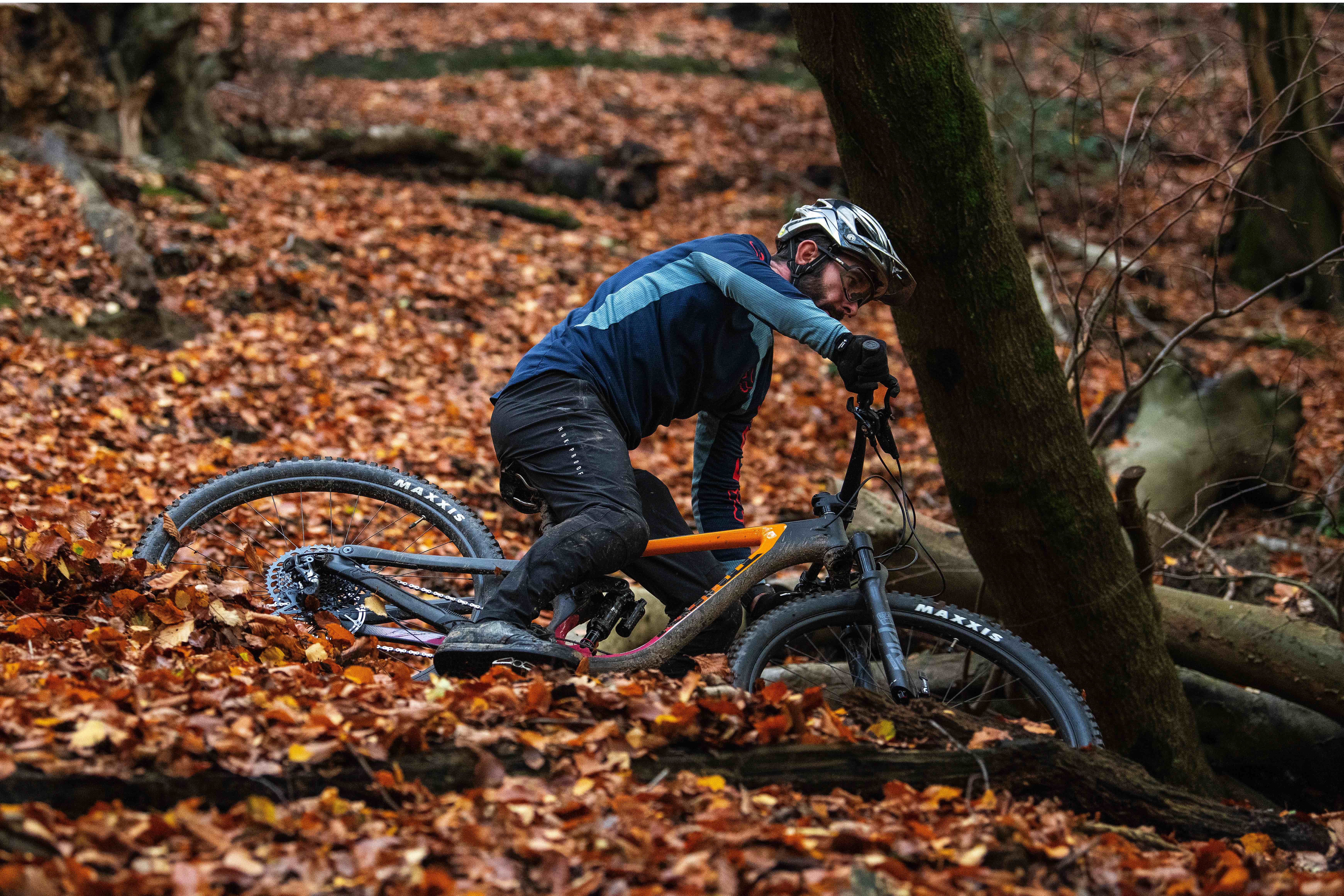
Wide mountain bike handlebars are becoming the norm, and provide extra stability, comfort and control.
Trail bikes follow this trend, many coming with a 760mm or 780mm bar, while some go up to 800mm. Just as smaller-sized trail bikes tend to have smaller 27.5in wheels, they also come with a narrower bar, going down 740mm, to help make the bike a better fit for smaller riders
Dropper posts

Dropper posts are almost standard on trail bikes.
They allow you to lower and raise your saddle with the flick of a handlebar-mounted button, giving you extra room to move your weight around on descents and the correct saddle height for efficient pedalling.
A dropper post is one of the first upgrades you should consider if your trail bike doesn't have one, because it will open the bike up to a wider range of riding.